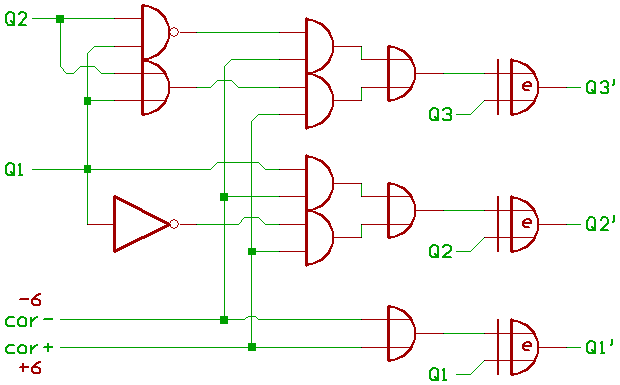
When using 74xx TTL, decimal correction could be done with a 74283 binary adder.
Adding 6 (binary 0110) is easy.
For 4 Bit, subtracting 6 would be the same as adding its two's
complement
decimal 10 (binary 1010).

The OR gate could be removed/eliminated by using the carry input:
we're simply adding 5+1 instead of 6.

When using transistors or logic gates, it isn't necessary to
rebuild a complete 74283.
We could build some half adders instead, and invert the Bits that
have to be corrected:

Now to describe, how it works.
For A+B, the positive maximum is 9+9+1 (when C_IN = 1), or decimal 19.
Q0..3 is the ALU result before, Q0..3' after decimal
correction.
X is Q0..3 XOR Q0..3'.
Now a list for what hapens, if Q is (decimal) 10..19:
binary binary binary Q3..0 Q3..0' X3..0 10 1010 0000 1010 11 1011 0001 1010 12 1100 0010 1110 13 1101 0011 1110 14 1110 0100 1010 15 1111 0101 1010 16 0000 0110 0110 17 0001 0111 0110 18 0010 1000 1010 19 0011 1001 1010
Well.
X0 is always 0,
X1 is always 1,
X2 is equal to !Q1,
X3 is zero, when Q1=0 and Q2=0.
For A-B, the negative maximum is 0-9-1 (when C_IN = 0, active borrow), or decimal -10.
As above, Q0..3 is the ALU result before, Q0..3' after
decimal correction.
X is Q0..3 XOR Q0..3'.
binary binary binary Q3..0 Q3..0' X3..0 -1 1111 1001 0110 -2 1110 1000 0110 -3 1101 0111 1010 -4 1100 0110 1010 -5 1011 0101 1110 -6 1010 0100 1110 -7 1001 0011 1010 -8 1000 0010 1010 -9 0111 0001 0110 -10 0110 0000 0110
X0 is always 0,
X1 is always 1.
X2 is equal to Q1,
X3 is zero, when Q1=1 and Q2=1.
So Q0..3 XOR X0..3 gives us Q0..3', and that's all.
The NMOS 6502 seems to use the same approach.
[2016: edit: this article was written before there was Visual6502.]
[HOME] [UP]/ [BACK] [1] [2] [3] [4] [5] [6] [7] [NEXT]
(c) Dieter Mueller 2006